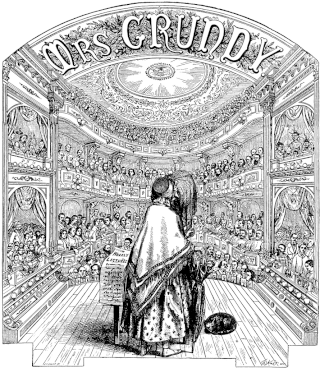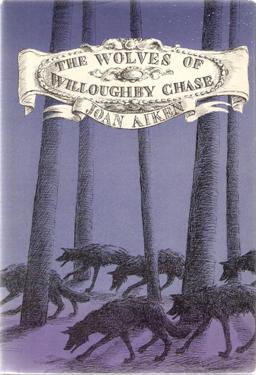
Sense and Sensibility is the first novel by the English author Jane Austen, published in 1811. It was published anonymously; By A Lady appears on the title page where the author's name might have been. It tells the story of the Dashwood sisters, Elinor and Marianne as they come of age. They have an older half-brother, John, and a younger sister, Margaret.

Cranford is an episodic novel by English author Elizabeth Gaskell. It first appeared in instalments in the magazine Household Words, then was published with minor revisions as a book with the title Cranford in 1853. The work slowly became popular and from the start of the 20th century it saw a number of dramatic treatments for the stage, the radio and TV.

Bleak House is a novel by English author Charles Dickens, first published as a 20-episode serial between 12 March 1852 and 12 September 1853. The novel has many characters and several subplots, and is told partly by the novel's heroine, Esther Summerson, and partly by an omniscient narrator. At the centre of Bleak House is a long-running legal case in the Court of Chancery, Jarndyce and Jarndyce, which comes about because a testator has written several conflicting wills. In a preface to the 1853 first edition, Dickens said there were many actual precedents for his fictional case. One such was probably Thellusson v Woodford, in which a will read in 1797 was contested and not determined until 1859. Though many in the legal profession criticised Dickens's satire as exaggerated, Bleak House helped support a judicial reform movement that culminated in the enactment of legal reform in the 1870s.
Sanditon (1817) is an unfinished novel by the English writer Jane Austen. In January 1817, Austen began work on a new novel she called The Brothers, later titled Sanditon, and completed twelve chapters before stopping work in mid-March 1817, probably because of illness. R.W. Chapman first published a transcription of the original manuscript in 1925 under the name Fragment of a Novel Written by Jane Austen, January–March 1817.

Nicholas Nickleby, or The Life and Adventures of Nicholas Nickleby, is the third novel by English author Charles Dickens, originally published as a serial from 1838 to 1839. The character of Nickleby is a young man who must support his mother and sister after his father dies.

Mrs Grundy is a figurative name for an extremely conventional or priggish person, a personification of the tyranny of conventional propriety. A tendency to be overly fearful of what others might think is sometimes referred to as grundyism.

Dombey and Son is a novel by English author Charles Dickens. It follows the fortunes of a shipping firm owner, who is frustrated at the lack of a son to follow him in his footsteps; he initially rejects his daughter's love before eventually becoming reconciled with her before his death.

John Albert Edward William Spencer-Churchill, 10th Duke of Marlborough,, styled Marquess of Blandford until 1934, was a British military officer and peer.

Devil's Cub is a Georgian romance novel written by Georgette Heyer. Set in 1780, it is the sequel to These Old Shades (1926). The book was published in 1932, and has not been out of print since. It is one of Heyer's most popular novels.

The Mysteries of Udolpho is a Gothic romance novel by Ann Radcliffe, which appeared in four volumes on 8 May 1794 from G. G. and J. Robinson of London. Her fourth and most popular novel, The Mysteries of Udolpho tells of Emily St. Aubert, who suffers misadventures that include the death of her mother and father, supernatural terrors in a gloomy castle, and machinations of Italian brigand Signor Montoni. It is often cited as an archetypal example of the Gothic novel.
The Palliser novels are six novels written in series by Anthony Trollope. They were more commonly known as the Parliamentary novels prior to their 1974 television dramatisation by the BBC broadcast as The Pallisers. Marketed as "polite literature" during their initial publication, the novels encompass several literary genres including: family saga, bildungsroman, picaresque, as well as satire and parody of Victorian life, and criticism of the British government's predilection for attracting corrupt and corruptible people to power.

The Wolves of Willoughby Chase is a children's novel by Joan Aiken, first published in 1962. Set in an alternative history of England, it tells of the adventures of cousins Bonnie and Sylvia and their friend Simon the goose-boy as they thwart the evil schemes of their governess Miss Slighcarp, and their so-called "teacher" at boarding school, Mrs. Brisket.
Eliza Parsons was an English Gothic novelist, best known for The Castle of Wolfenbach (1793) and The Mysterious Warning (1796). These are two of the seven Gothic titles recommended as reading by a character in Jane Austen's novel Northanger Abbey.

The Castle of Wolfenbach (1793) is the most famous novel written by the English Gothic novelist Eliza Parsons. First published in two volumes in 1793, it is among the seven "horrid novels" recommended by the character Isabella Thorpe in Jane Austen's novel Northanger Abbey and an important early work in the genre, predating Ann Radcliffe's The Mysteries of Udolpho and Matthew Lewis's The Monk.
Dear creature! How much I am obliged to you; and when you have finished Udolpho, we will read The Italian together; and I have made out a list of ten or twelve more of the same kind for you.
Have you, indeed! How glad I am! What are they all?
I will read you their names directly; here they are, in my pocketbook. Castle of Wolfenbach, Clermont, Mysterious Warnings, Necromancer of the Black Forest, Midnight Bell, Orphan of the Rhine, and Horrid Mysteries. Those will last us some time.
Yes, pretty well; but are they all horrid, are you sure they are all horrid?

The Cater Street Hangman is a crime novel by Anne Perry. It is the first in a series which features the husband-and-wife team of Thomas and Charlotte Pitt.

The Wolves of Willoughby Chase is a 1989 dark fantasy film directed by Stuart Orme with a screenplay by William M. Akers. The film was based on the 1962 novel of the same name, written by Joan Aiken. Like the book, the film is set in an alternate history version of nineteenth century England where wolves roam the countryside.

Mr William Collins is a fictional character in the 1813 novel Pride and Prejudice by Jane Austen. He is the distant cousin of Mr Bennet, a clergyman and holder of a valuable living at the Hunsford parsonage near Rosings Park, the estate of his patroness Lady Catherine De Bourgh, in Kent. Since Mr and Mrs Bennet have no sons, Mr Collins is also the current heir presumptive to the Bennet family estate of Longbourn in Meryton, Hertfordshire, due to the estate being entailed to heirs male. Mr Collins is first introduced during his visit to Longbourn.

Elizabeth Hervey (1748–1820) was the author of seven novels, six of which were published and one of which exists "in a carefully-bound manuscript."















